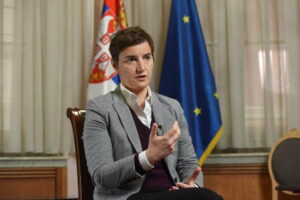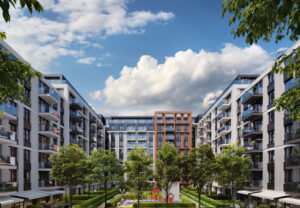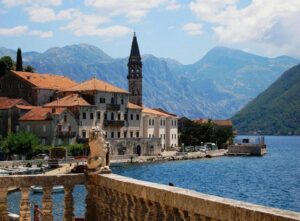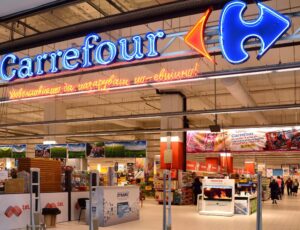
According to Serbian Economist, Serbian National Assembly President Ana Brnabić is visiting Ukraine on November 10. The program includes meetings in the Verkhovna Rada and talks with Ukraine’s top leadership, according to the Serbian Parliament’s press service.
During her visit, Brnabić stated that Serbia supports Ukraine on its European path and is ready to share its experience of parliamentary and technical integration with the EU. Verkhovna Rada Chairman Ruslan Stefanchuk expressed his gratitude for interparliamentary cooperation and support.
The heads of the parliaments have been in contact since the summer of 2025 — in August, the parties agreed on positions on the international agenda and interparliamentary cooperation.
Source: https://t.me/relocationrs/1720

According to Serbian Economist, the Serbian parliament has passed a special law that accelerates preparations for the development of the site of the former Yugoslav National Army General Staff Headquarters in central Belgrade, which was damaged by NATO strikes in 1999. The developer is Affinity Global Development, an investment company founded by US President Donald Trump’s son-in-law Jared Kushner.
The project, worth about $500 million, involves the construction of a hotel, apartments, offices, and retail space, as well as a memorial space for the victims of the bombing.
A 99-year lease agreement with the Serbian government was signed in May 2024. In November 2024, the site was stripped of its protected cultural heritage status, paving the way for the project to go ahead. The adopted lex specialis simplifies and speeds up the issuance of permits and other administrative procedures, the authorities noted.
The opposition and relevant organizations criticize the decision, citing the cultural value of the complex and legal risks. Europa Nostra has included the General Staff Headquarters in its list of the seven most vulnerable European heritage sites of 2025. Radio Liberty notes that the law was passed with the votes of the ruling party, despite protests and an investigation into possible falsification of the document used to remove the protective status.
Affinity Global Development’s public statements and official communications do not mention the hotel brand, number of rooms, number of floors, room area, parking, or exact completion date. International agencies limit themselves to describing the functional mix without specifications. When official materials on the TEP and branding appear, the editorial staff of Serbian Economist will clarify the data.
The government is promoting the project as an investment and revitalization of Belgrade’s central location. Critics believe that the demolition and new construction will damage the modernist legacy of architect Nikola Dobrovic and the public memory of the events of 1999.
https://t.me/relocationrs/1705

Apartment prices in Serbia in the second quarter of 2025 were 5.78% higher than a year earlier; compared to the first quarter, the increase was 1.36%, according to the statistics agency. In the old housing stock, annual growth reached 5.89%, and in new buildings, 5.57%.
According to Eurostat data for the same period, the average growth in housing prices in the EU was 5.4% year-on-year, with significant variations: from a decline of 1.33% in Finland to growth of 17.23% in Portugal, 15.51% in Bulgaria, and 15.12% in Hungary.
The main trends in the real estate market in Serbia at the moment are as follows:
1) The balance of demand is shifting in favor of fully finished apartments and energy-efficient new buildings in large agglomerations, primarily in Belgrade and Novi Sad.
2) The price gap between new buildings and secondary housing remains significant, but the rates of increase are similar — 5.57% versus 5.89% year-on-year, indicating broad demand support for both segments.
3) The external background is neutral-positive: Serbian dynamics are close to the European average, but without the overheating characteristic of a number of EU markets.
Vera Yegorova-Tolsta, director of the Vidovstan real estate agency (Belgrade), commented on the market situation for Serbian Economist:
“We see sustained interest in well-located properties with clear operating economics — these are new business-class buildings and liquid secondary properties with reasonable utility costs. Buyers have become more careful in comparing options in terms of energy efficiency and management infrastructure, which supports quality projects even at a higher price per square meter. In Belgrade, offers that meet these criteria continue to sell quickly, thanks to local demand and buyers moving from other cities.”
Given the current trajectory of interest rates and household incomes, the baseline scenario is moderate price growth within the limits of inflation plus a premium for location and energy efficiency.
Risk factors for prices include a slowdown in mortgage lending and rising developer costs; support factors include limited supply in prime locations and a moderate influx of internal migrants to the Belgrade agglomeration.

According to Serbian Economist, Chinese automaker Chery is discussing with the Serbian government the possibility of opening a production plant in Serbia. In Shanghai, Serbian Deputy Prime Minister and Economy Minister Adriana Mesarovic held talks with Chery Chairman Yin Tongyue, the parties discussed the conditions of potential localization and further steps, Serbian publication Telegraf reported, citing Mesarovic’s statement.
According to the minister, Serbia’s status as a “gateway to Europe” and the free trade agreement with China create additional opportunities for investors, including access to a number of trade agreements when localizing more than 51% of the value added of products. Mesarovic also said that she expects Chery’s head to visit Belgrade to continue negotiations.
Specific parameters of the investment project, terms and location were not disclosed.
In 2025, Serbia has already announced a project for the construction of an electric car plant of Chinese JMEV in Sremska Mitrovica with export orientation to the EU market. Against the backdrop of the expanding presence of Chinese carmakers in the region, Chery is developing its European sales network and localization initiatives in parallel.
https://t.me/relocationrs/1699

As reported by the Serbian Economist, the Government of Montenegro at a meeting of the Council of National Security approved a package of measures to tighten migration policy, including a proposal to fix in the Law on Foreigners the minimum value of real estate € 200 thousand as a basis for granting temporary residence. This is stated in the official message of the Cabinet of Ministers.
Among other decisions of the Council is the instruction to the Ministry of Foreign Affairs to prepare amendments to the decree on visa regime, which will reduce the period of visa-free stay for citizens of countries not aligned with the EU visa policy from 90 to 30 days. The Council also ordered that data on dormant and inactive foreign-owned companies be handed over to the police for verification and possible revocation of previously issued residence permits.
The government notes that the “company for the sake of a residence permit” ground is planned to be replaced by the requirement of full employment with a registered employer or an established company. At the same time, local media specify that the Parliament has introduced amendments, according to which the extension of residence permit for the founder of the company will be possible if there are at least three full-time employees, of which at least one Montenegrin citizen, and the extension of residence permit for real estate will depend on its value and size. These norms are to be detailed in bylaws.
Podgorica emphasizes that the measures are aimed at aligning the rules with EU approaches and strengthening control over migration flows. The final changes will require the adoption of amendments to the law and bylaws.
https://t.me/relocationrs/1698

According to Serbian Economist, the Serbian Ministry of Internal and Foreign Trade reported that on November 3, Minister Jagoda Lazarevic met with representatives of Carrefour, who confirmed their interest in entering the Serbian market. According to the ministry, the retail chain is considering direct entry without intermediaries, intends to make Serbia a regional hub and attract local suppliers; negotiations will continue and Carrefour’s top management will come to Serbia by the end of this year.
Serbian business publications, referring to the minister’s statement, specify that the working model is being discussed in several formats, including the search for local franchise partners, while the basic scenario is the direct presence of the chain. The ministry positions the possible arrival of a new player as a way to strengthen competition and offer a wider range of products at competitive prices.
Tanjug Agency notes that Carrefour’s interest in Serbia fits into the Balkan expansion of the chain; previously, specialized resources reported about the exclusive rights of the Greek structure to develop the brand in the region, but the current statements of Belgrade emphasize the direct entry into the market.
The company has not officially announced specific launch dates and locations.
Earlier, Serbian Economist reported about the chain’s negotiations about entering Serbia, but without final decisions. The final terms and format of the presence will depend on the results of the management visit, availability of suitable retail space and agreement of terms with the regulator and potential local partners.
https://t.me/relocationrs/1691